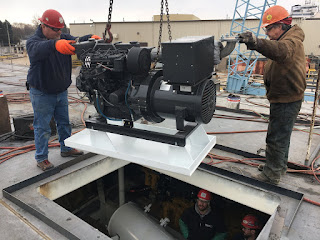More major milestones were met this week immediately following turnover and joining of the two hull sections Tuesday, Jan. 8.
With the one-piece hull sitting on blocks outdoors near the Fincantieri graving dock, welding to securely fasten the two sections as one began in earnest. First, there was an alignment process, or "regulating," of the two sections, to make certain they were in perfect position: no gaps, no buckling, only fair and smooth flow of the deck and hull lines. This was achieved, in part, through use of strings, measuring devices, but also by eye, before welders began their work permanently connecting the two sections. The fact these two halves had been built in the shed, touching one another, meant they had been manufactured in alignment at the earlier building stage. (I reported in error in an earlier blog by indicating some 4-6 inches gap remained between the two. In fact, although the hull and deck plates were never joined, several smaller steel members ran from one half continuously into the other. These were snipped before the two sections were separated.)
 |
| Northern Lights gensets engine frames (in white) on shop floor, awaiting installation. |

Once the hull was sufficiently joined, main engine/gear packages were lowered by gantry crane into main deck openings and clamped securely in place to avoid shifting when the hull is once again moved indoors. (Patches fabricated for closing those main deck openings were set down later, to keep out snow and rain, and to make a safer surface for workers. Once access from above is no longer required - sometime before an April launch - those hatch covers will be securely bolted, making them a continuation of the vehicle deck structure.)
Following main engine installation, and a lube oil tank, two generators were lowered to the machinery space. These were pre-mounted to frames, ready for setting.
 |
| Pedestal structure on transporter, exiting Bldg. 311 for installation. |

Friday afternoon the pedestal with cabin superstructure was brought out from Bldg. 311 where it had been assembled. Before this piece was set, welding of deck seams in that area was completed. Watertight testing of the voids beneath, as observed by a U. S. Coast Guard Safety Inspector, passed certification. The pedestal "skirt," where vertical sheets met the deck, had been cut with excess material, and once set down on the main deck marks the unit was leveled and the base scribed to follow the curvature of the main deck plates. All of this took place prior to the final welding in place of the superstructure.
All of the above photos were taken by Rich Ellefson, who has put in long hours at the yard, following construction progress and details, helping to resolve construction questions, and smoothing the coordination and flow between owner, designer, builder and regulator.


1 comment:
If I read this right, smaller cars will go in the pedestal structure? Looks like a tight fit, but I'm sure its bigger in person.
Post a Comment